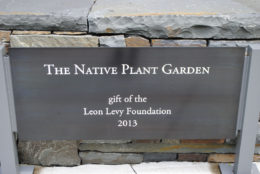 I was so happy to finally have the chance to visit the New York Botanical Garden, during their 125th anniversary no less! I blocked out the entire day to explore as much as I could of this massive, 250-acre garden in the Bronx, and while I wasn’t able to see everything, I did manage to cover a lot of ground.
I was so happy to finally have the chance to visit the New York Botanical Garden, during their 125th anniversary no less! I blocked out the entire day to explore as much as I could of this massive, 250-acre garden in the Bronx, and while I wasn’t able to see everything, I did manage to cover a lot of ground.
The 3-acre Native Garden was nothing short of spectacular, designed by Oehme van Sweden Landscape Design. Over 100,000 native plants are thoughtfully placed to not only demonstrate their unique natural environments but also to show how stunning they can be when used in everyday gardens.
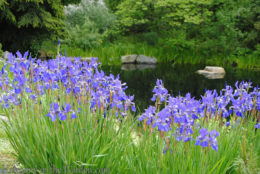 There are a lot of opinions and definitions as to what makes a plant ‘native’ or not.
There are a lot of opinions and definitions as to what makes a plant ‘native’ or not.
I particularly like NYBG’s definition:
In the simplest terms, a plant is considered native to northeastern North America if it grew here naturally before the arrival of the first European settlers. To botanists, a native plant is any species that grows and spreads spontaneously in a given habitat in a given geographic region. To ecologists, a native plant has evolved over time within a complex and changing web of climate and geology. To gardeners, a native plant represents an opportunity to embrace a bit of their local floral heritage in a landscape reshaped by human activity.
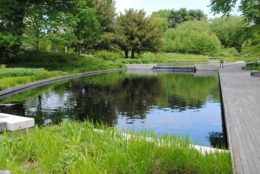
The focal point of the Native Garden is a 230-foot water feature that uses recycled storm-water filtered with aquatic plants.
Surrounding this water feature are meandering native locust hardwood pathways that gently lead visitors through lush woodlands and prairie meadows.
Here are some of the highlights of my day:
Prairie/Meadow Garden

Since the day was getting warm, I headed first to the sunny meadow.
Having spent my life on the West coast, I’ve always longed to see the prairie wildflowers of which I’ve read so much about over the years.
My favorite was when I spotted the Prairie Smoke (geum triflorum) hiding among taller plants.
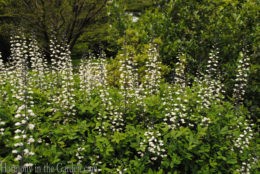
Seeing this large stand of White Wild Indigo (baptisia alba) just about knocked my socks off – oh, what I woudn’t give to be able to grow this in my garden.
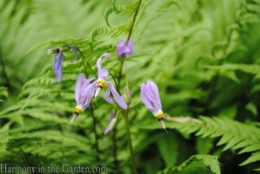
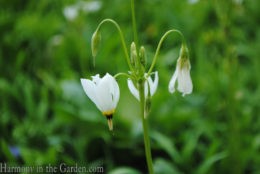
Even though Shooting Stars (dodecatheon meadia) are found throughout the United States, I’ve never seen one in the wild, so, of course, I let out a little scream of delight when I found them in not only one but two colors!
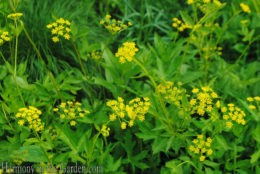
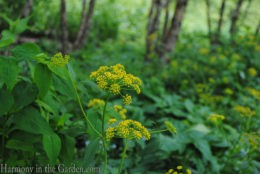
Over the past few years, I’ve become more and more enamored with umbillifers (plants that belong to the carrot or cow parsley family.) Umbillifers typically have delicate clusters of flowers that have open-umbrella shapes that appear to float through the garden bed, such as this Golden Alexander (zizia aurea.)

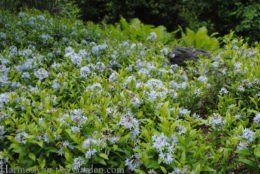
What prairie would be complete without a stand of Blue Stars (amsonia hubrichtii)? In this native garden there were plenty of the taller, more common Blue Star, as well as a dwarf variety called amsonia montana ‘Short Stack’, topping out at 12″ tall.
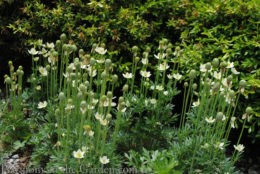
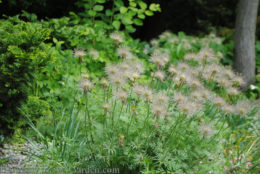
In the drier part of the garden was something a little more familiar to me – the Pacific Anemone (anemone multifida). The linear lines of its tidy white flowers followed by fluffy, silky sead heads make this a fantastic native for the front of a border.
Shady Woodlands
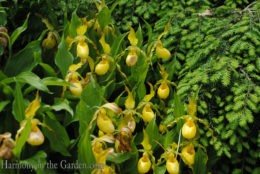
As the day warmed up, I welcomed the cooling shade of the woodland section of the native garden.
And if the temperature change wasn’t enough, the lush stand of bright yellow Lady’s Slippers (cypripedium parviflorun var. pubescens) was a clear indication that we were not in the prairie any longer!

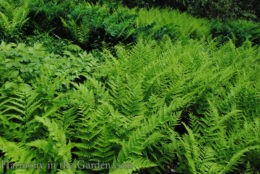
Ferns of all varieties were everywhere, including the delicate and wiry Northern Maidenhair Fern (adiantum pedatum) and the bold and structural Wood Fern (dryopteris marginalis).
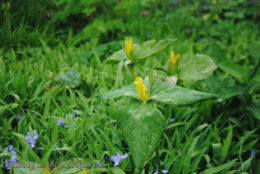
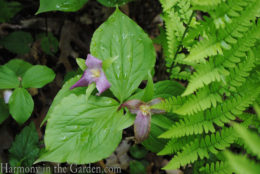
Spotting the Great White Trillium (trillium grandiflorum) was another breathtaking moment, as I’ve never been lucky enough to spot this spring ephemeral growing in the wild. I’ve always known ephemerals are plants with a short life-cycle, but I appreciated the in-depth explanation the NYBG offers and, in particular, why the Trillium is so fragile:
Ephemerals develop the aerial parts (i.e. stems, leaves and flowers) of the plant early each spring (hence the nickname Wake Robin) and then quickly bloom, and produce seed. The leaves wither, leaving only underground structures (roots, rhizomes, and bulbs) for the remainder of the year. While they are beautiful to look at they are also extremely fragile, and picking them seriously injures the plant by preventing the leaf-like bracts from producing food for the next year, often effectively killing the plant and ensuring none will grow in its place. Can take up to 7 years to flower from when the seed is planted.
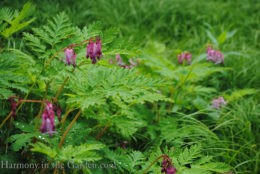
The wild form of Bleeding Heart (dicentra eximia), with its smaller and elongated dark pink heart-shaped flowers is another spring ephemeral.
Native to the Appalachian Mountains, the foliage and flowers are much longer lasting than the common variety, often blooming through the entire summer.
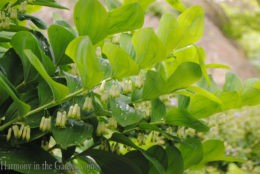
I know, I know…this is a common plant for many of you but to someone who gardens in hot and dry California, it’s a novelty.
I loved the bright green leaves of the Smooth Solomon’s Seal (polygonatum bilorum) with its danging ‘earrings’ tipped in green.
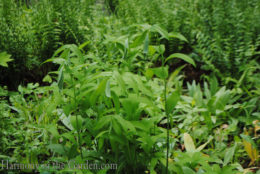
Have you noticed the umpteen different ways that Ramps (or Wild Leeks) are offered on restaurant menus these days?
Well, it’s becoming a problem for this poor native. Due to their delicious flavor (a cross between garlic and onion) and the various Ramp Festivals throughout the Appalachians, the allium tricoccum are becoming more and more scarce in the wild.
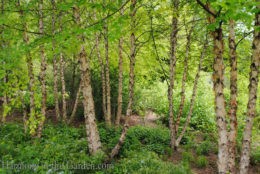
The unusual salmon-beige color of the peeling bark of the River Birch (betula nigra ‘Heritage’) would be stunning in a winter garden, don’t you think?
In lighter shades than the dark cinnamon color of traditional River Birch, it brightens up this shady grove.
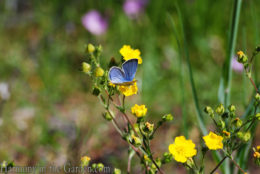
Over the past few years I’ve become more and more intrigued with native plants, and the importance of incorporating them into our gardens. They not only to help the native insects and wildlife but to help us embrace where we live, to celebrate our ‘sense of terroir’, our ‘sense of place’.
I’d love to know what some of your favorite native plants are, and how you use them in your gardens!







8 Comments
Rebecca, what a lovely article. The trilliums remind me of the wooded areas around my old home town in Ottawa, Ontario where they grow prolifically, but I’ve also seen some giant version of them growing along the hiking trails in Portola Valley.
Thank you, Nancy. You’ve seen them in Portola Valley? Okay…now I’m on a mission to see them in person!!
Rebecca,
Thank you for taking us on the tour with you! Absolutely gorgeous! It’s on my bucket list of gardens to visit! As you can imagine it is a very long list ;0) If you want to see trilliums in the wild you need to come and visit the South Puget Sound (we have them everywhere in the spring.) Native Plant Salvage here in Olympia, nativeplantsalvage.org/calendar does plant walks throughout the year (sorry for the shameless plug, I’m on the board and I just love sharing all the wonderful programs that the foundation offers!)
Thank you, Rachel, for letting us all know about your wonderful program! I might just have to visit to see them in the wild – thanks for the calendar!!
What a great visit! Your photos are so inspiring, I can only imagine how wonderful it must have been to see the real thing!
Thanks, Heidi, I appreciate the compliment. Yes, it was amazing to take my time and explore the whole garden to find these little gems!
Thank you for this introduction to so many beautiful plants. What is the effect en masse? Are these mostly tiny flowers buried deep in foliage? I wondered as your first pic looks grassy rather than colourful.
The effect of en masse (like the amsonnia) is truly stunning, but I think photo you’re referring to is the pond, right? There are lots of varieties of carex grasses that surround it which is why it’s so green. Many of the flowers are tiny, indeed, but because of the larger drifts they’re stunning. Too hard to capture, though, so I focused on close-ups. Thanks for stopping by, Catherine!